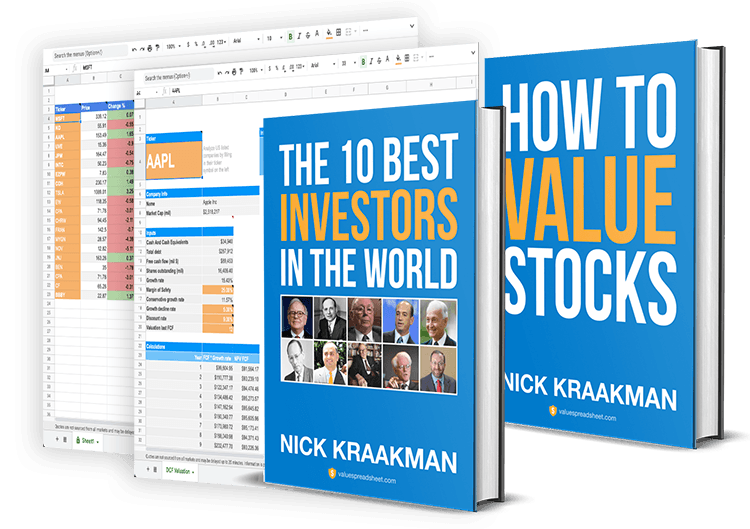Transcript
Hello everybody, welcome to the 18th episode of the Value Investing Bootcamp podcast.
Thanks so much for tuning in again.
As always, I'm your host, Nick Kraakman, and in the previous episodes, we talked about interest rates, growth rates, and discount rates.
I hope everything about that is clear.
If not, shoot me an email with your questions,
Today we have another interesting topic to cover.
Many people ask me this question; when should I buy and when should I sell?
Well, everyone knows the adagio which says buy low, sell high, and this is exactly what I propose to you, buy low, sell high.
Warren Buffett said, “Be fearful when others are greedy, and greedy when others are fearful.”
In other words, you should buy when people are very pessimistic, because this creates very low share prices, and sell when people are optimistic and stocks get hyped and overvalued.
That's when you want to sell, because that's when you get the best price for your stocks.
So, that's the first thing I want to say.
However, buying at a low price, it depends on several things; how low, for example, should your price be?
We already discussed in previous episodes how you can calculate an estimate of the intrinsic value of a company, and that you can then compare the current stock price with that value and see whether it's cheap or not.
The difference between your purchase price and intrinsic value is called the margin of safety, and the further you buy below the intrinsic value, the bigger your margin of safety.
And this margin of safety is a crucial aspect of value investing.
Warren Buffett once called it the three most important words in investing, and that says a lot coming from his mouth.
So, why is it so important?
Well, because a margin of safety actually creates room for error.
That's one thing.
So, because we are working with imperfect information, we have to build in some room for error, because our estimates could be wrong.
The company could not perform as well as we expect, but still we want to make money, or at least minimize the risk of losing money, and the only way to do this is to purchase at a price which is significantly lower than the intrinsic value of the company.
That way you, for example, if you purchase $1 of value for 50 cents, then you have a big margin of safety, and your upside potential is high, and your downside potential is relatively small, because you already purchased at such a low price.
But even if the value of the company appears not to be $1, but just $70 cents, you still make $20 cents profit if you purchase that for $50 cents.
This is why intrinsic value and a margin of safety is so crucial.
So, how big should your margin of safety be?
Well, I usually aim for a margin of safety between 50 and 100%.
This means that just like in the example before, I would purchase a stock only if I expect an upside potential of between 50 and 100%.
We also discussed in earlier episodes that it can take up to several years before this value, this gap between price and value, is finally closed.
So, if you have a 100% profit potential, and it takes five years to get there, yeah, you're around 20% a year, which is perfect, and if it's quicker, you have even more per year, a better return per year.
So, that's what I would aim for.
But maybe even more important is the fact, when will you sell?
Because yeah, sure you can purchase at a great price, but when will you finally decide to sell, because a stock can always go higher.
And it is impossible to predict the future stock price movements, so how can you possibly know when to sell?
Well, this is a question that I receive often, and actually the answer is pretty straightforward.
Again, you just compare the price to the intrinsic value that you calculated.
So, if the stock price comes near that value, it means that the stock is fairly valued and is no longer undervalued, which means that it no longer has a lot of upside potential, then you are better off selling and putting your money into a better opportunity, which is priced much lower than your current holding.
So, sell when you find a better opportunity to invest your money, a more attractive stock to invest your money in which has more upside potential left, that's one thing.
Another thing is something can change.
I mean, you purchase a company which is perfectly healthy, everything is going great, you get it at a nice price, and then something happens.
Sometimes short term things happen, like a lawsuit or an investigation, which can push the price down to unreasonably low levels, but these are often short term things.
Once the lawsuit is over, the stock is fine again, and they probably have to pay a fine if they lose, but most of the time these fines are just, you know, they can pay it and they have the money for it.
So, they pay it, they have a bit less profit that year, and then they move on, you know, they keep going strong.
But sometimes something fundamentally changes.
Sometimes something happens with a company, like a new competitor enters the market who just crushes their business model.
In this case, your initial thesis to buy this company no longer stands, it no longer holds, because something fundamentally changed, and this might not necessarily mean that your thesis is wrong.
I mean, sometimes you can still hold on to the company, if it is still able to push out a nice return, but sometimes these fundamental changes are so strong that you just are better off selling it and looking for better opportunities.
So, I hope it is clear that you buy when prices are low, you buy at a significant discount to the intrinsic value.
This is called the margin of safety, and the bigger the margin of safety, the safer you are and the more upside potential you have.
And you sell whenever the stock price comes close to the intrinsic value, or when you find a better opportunity, or if something fundamentally changes with the company that you own.
So, that's all about when to buy and when to sell.
In the next episode, we'll look into some portfolio management, so how should you diversify, and how many stocks should you buy, things like that.
I'll see you in that episode, which will be the second to last episodes of this podcast.
I’m starting to get emotional... No, I'm still good, but I hope you're still enjoying it and I'll see you in the next episode!
If you enjoyed today's show, head over to ValueInvestingBootcamp.com to find out more on how you can invest like the pros, manage your own portfolio with confidence, and consistently earn mind boggling returns on the stock market.



